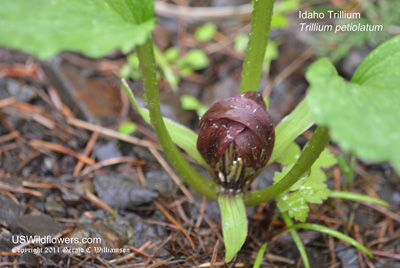Idaho Trillium, Long-petioled Trillium, Purple Trillium, Round Leaf Trillium, Purple Wakerobin - Trillium petiolatum
|
Trillium petiolatum - Idaho Trillium, Long-petioled Trillium, Purple Trillium, Round Leaf Trillium, Purple Wakerobin. An unusual trillium with plantain-like leaves found primarily in the region where the states of Idaho, Oregon, and Washington come together. It may be 8 to 10 inches tall.
Found in:
ID, OR, WA
Leave comments on Trillium petiolatum at this link. | 
Distribution of Trillium petiolatum in the United States and Canada:

Blue=Native; Grey=Introduced
Map from USDA Plants Database:
USDA, NRCS. 2017. The PLANTS Database (http://plants.usda.gov, 08 May 2025). National Plant Data Team, Greensboro, NC 27401-4901 USA.
Search Our Database: Enter any portion of the Scientific, Common Name, or both.
Do a general Google search of the entire site:
#ad
 Follow USWildflowers on Twitter
| | Site: Payette National Forest, Adams County, ID Date: 2011-June-18 | Photographer: Gerald C. Williamson
Nikon D7000
Tamron SP 90MM f/2.8 AF Macro | | Unlike any other Trillium species, Idaho Trillium has petioled leaves, from whence comes the species epithet, and the leaves rise well above the blossom. The blossom is just above the 3 green sepals, which in turn are just off the ground. Other trilliums flower above the leaves, although several have blossoms which nod below the leave on the pedicel. The color of the Idaho Trillium blossom can vary similarly to that of T. cuneatum, usually being maroon or purple, but may also be greenish or somewhat yellow. | | 
| | Site: Payette National Forest, Adams County, ID Date: 2011-June-18 | Photographer: Gerald C Williamson
Nikon D7000
Tamron SP 90MM f/2.8 AF Macro | | We were checking out the Huckleberry Campground in the Payette National Forest when I spotted this odd trillium. It was raining, but I jumped out for a couple of quick hand-held shots. Unfortunately the blossom wasn't fully open. From what I've read, June 18 is late for this species to be blooming, but we were at 4000'+, at the upper end of the normal range for this plant, and it had been a late spring. | | Click on the photo for a larger image

|
References used for identification and information:
|
|
| |
| #ad
|
|




